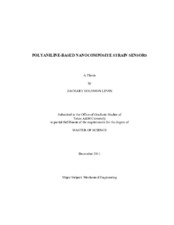| dc.description.abstract | Health monitoring is an important field as small failures can build up and cause a catastrophic failure. Monitoring the health of a structure can be done by measuring the motion of the structure through the use of strain sensors. The limitations of current strain sensing technology; cost, size, form could be improved. This research intends to improve current strain sensing technology by creating a conductive polymer composite that can be used monitor health in structures. Conductive polymer composites are a viable candidate due to the low costs of manufacturing, tailorable mechanical and electrical properties, and uniform microstructure. This work will focus on determining if a all-polymer composite can be used as a strain sensor, and investigating the effects of filler, doping and latex effect the electrical and strain sensing properties.
Strain sensors were prepared from polyaniline (PANI)-latex composites, the morphology, mechanical, electrical and strain sensing properties were evaluated. These strain sensors were capable of repeatable measuring strain to 1% and able to measure strain until the substrates failure at 5% strain, with a sensitivity (measured by gauge factor) of between 6-8 (metal foil strain sensors have a gauge factor of 2). The best performing strain sensor consisted of 4 wt.% polyaniline. This composition had the best combination of gauge factor, linearity, and signal stability.
Further experiments were conducting to see if improvements could be made by changing the polymer used for the matrix material, the molecular weight and the level of doping of the polyaniline. Results indicate through differences in strain sensing response; lower hysteresis and unrecoverable conductivity, that polyaniline latex composites can be adjusted to further improve their performance.
The polyaniline-latex composites were able to repeatable measure strain to 1%, as well as strain until failure and with gauge factor between 6-8, and a 70% increase in signal at failure. These properties make these composites viable candidates to monitor health in structures, buildings, bridges, and damns. | en |


